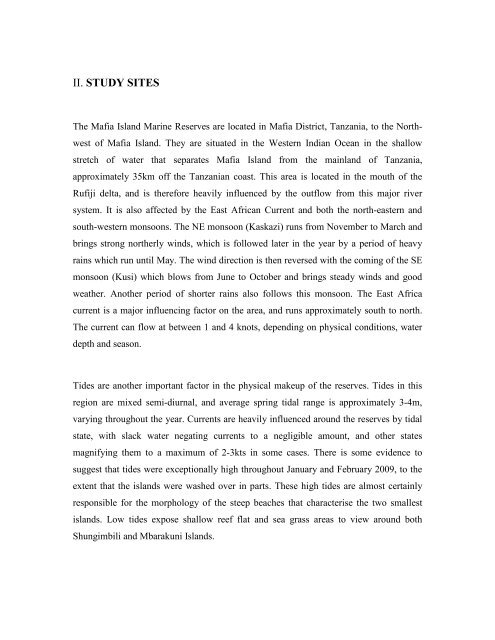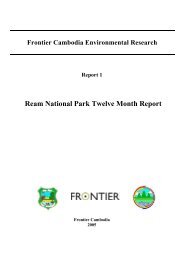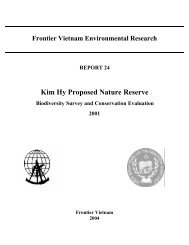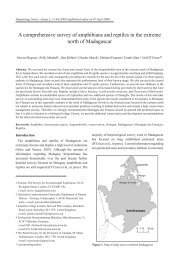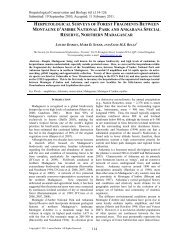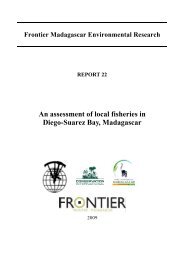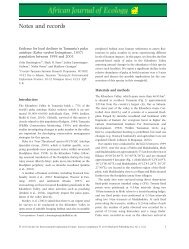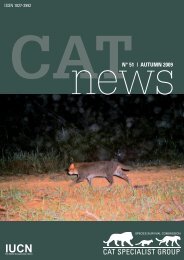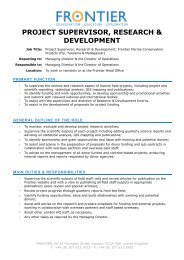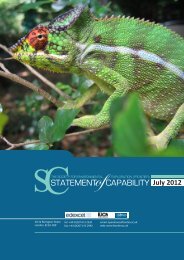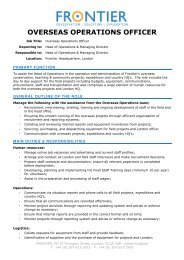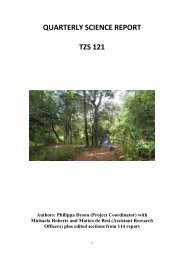Biophysical Survey of Mafia Island Marine Reserves
Biophysical Survey of Mafia Island Marine Reserves
Biophysical Survey of Mafia Island Marine Reserves
You also want an ePaper? Increase the reach of your titles
YUMPU automatically turns print PDFs into web optimized ePapers that Google loves.
II. STUDY SITES<br />
The <strong>Mafia</strong> <strong>Island</strong> <strong>Marine</strong> <strong>Reserves</strong> are located in <strong>Mafia</strong> District, Tanzania, to the North-<br />
west <strong>of</strong> <strong>Mafia</strong> <strong>Island</strong>. They are situated in the Western Indian Ocean in the shallow<br />
stretch <strong>of</strong> water that separates <strong>Mafia</strong> <strong>Island</strong> from the mainland <strong>of</strong> Tanzania,<br />
approximately 35km <strong>of</strong>f the Tanzanian coast. This area is located in the mouth <strong>of</strong> the<br />
Rufiji delta, and is therefore heavily influenced by the outflow from this major river<br />
system. It is also affected by the East African Current and both the north-eastern and<br />
south-western monsoons. The NE monsoon (Kaskazi) runs from November to March and<br />
brings strong northerly winds, which is followed later in the year by a period <strong>of</strong> heavy<br />
rains which run until May. The wind direction is then reversed with the coming <strong>of</strong> the SE<br />
monsoon (Kusi) which blows from June to October and brings steady winds and good<br />
weather. Another period <strong>of</strong> shorter rains also follows this monsoon. The East Africa<br />
current is a major influencing factor on the area, and runs approximately south to north.<br />
The current can flow at between 1 and 4 knots, depending on physical conditions, water<br />
depth and season.<br />
Tides are another important factor in the physical makeup <strong>of</strong> the reserves. Tides in this<br />
region are mixed semi-diurnal, and average spring tidal range is approximately 3-4m,<br />
varying throughout the year. Currents are heavily influenced around the reserves by tidal<br />
state, with slack water negating currents to a negligible amount, and other states<br />
magnifying them to a maximum <strong>of</strong> 2-3kts in some cases. There is some evidence to<br />
suggest that tides were exceptionally high throughout January and February 2009, to the<br />
extent that the islands were washed over in parts. These high tides are almost certainly<br />
responsible for the morphology <strong>of</strong> the steep beaches that characterise the two smallest<br />
islands. Low tides expose shallow reef flat and sea grass areas to view around both<br />
Shungimbili and Mbarakuni <strong>Island</strong>s.


